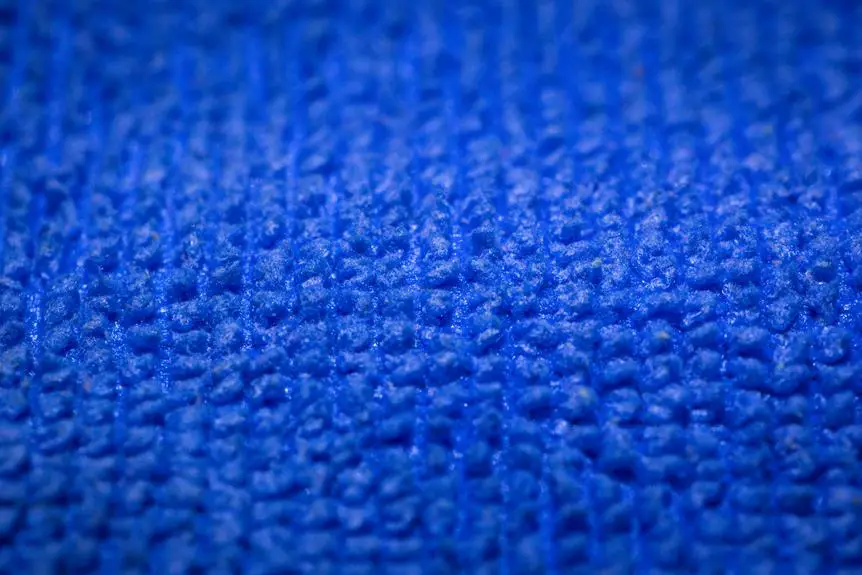You might be surprised to learn just how stretchy microfiber can be, thanks to its unique blend of polyester and polyamide. This combination not only provides a snug fit but also allows the fabric to return to its original shape after stretching. While natural fibers often fall short in elasticity, microfiber's synthetic nature opens up a range of applications that prioritize both comfort and movement. But what factors really influence its stretchiness, and how does it compare to other fabrics? Let's explore these aspects further.
Table of Contents
Key Takeaways
- Microfiber, composed of polyester and polyamide, exhibits excellent elasticity, allowing it to stretch and return to its original shape effectively.
- The combination of synthetic fibers in microfiber enhances its stretchability compared to natural fibers like cotton and wool.
- Weaving techniques and finishing processes can influence the stretchiness of microfiber fabrics, affecting their overall elasticity.
- Microfiber's superior flexibility makes it ideal for comfort in activewear and other high-performance textiles.
Understanding Microfiber Composition
Microfiber typically consists of a blend of polyester and polyamide, which gives it unique properties that enhance its durability and softness. This combination results in a fabric that's not only lightweight but also highly absorbent. When you touch microfiber, you'll notice its smooth texture, making it ideal for various applications, from cleaning cloths to clothing.
The polyester component contributes to the fabric's strength and resistance to wear and tear. It also helps in moisture-wicking, allowing sweat to evaporate quickly, keeping you comfortable in different conditions. On the other hand, polyamide adds a level of stretchiness and flexibility, which means that microfiber can conform to various shapes without losing its original form.
You'll find that microfiber is often used in high-performance textiles because of these qualities. Whether you're using microfiber towels or athletic wear, you can trust that the fabric will hold up over time. Understanding this composition helps you appreciate why microfiber is favored for its versatility and practicality in everyday life.
Elasticity in Fabrics Explained
Elasticity in fabrics refers to the ability of a material to stretch and return to its original shape, making it essential for comfort and fit in clothing. When you wear garments, you want them to move with your body, and that's where elasticity comes into play. Fabrics with good elasticity can adjust to your movements, providing freedom and comfort throughout the day.
There are different types of fibers that contribute to a fabric's elasticity. Natural fibers like cotton and wool offer some degree of stretch, but synthetic fibers like spandex and polyester often provide superior elasticity. These materials can stretch significantly without losing their shape, making them popular choices for activewear and form-fitting clothing.
Understanding elasticity also helps you choose the right fabric for your needs. If you're looking for something that hugs your body, opt for fabrics with higher elastic content. On the other hand, if you prefer a looser fit, look for materials with less stretch.
In short, knowing how elasticity works in fabrics can help you make informed choices for your wardrobe, ensuring you get the comfort and style you desire.
How Microfiber Is Made
When you look at microfiber, it's important to understand how it's made.
It starts with specific raw materials, which are then processed through a unique manufacturing process.
Let's break down these essential components to see how they come together to create this versatile fabric.
Raw Materials Used
Made from a blend of polyester and polyamide, microfiber is crafted through a process that involves splitting fibers to create a soft and durable material. These two raw materials work together to give microfiber its unique characteristics, such as strength, resilience, and moisture-wicking abilities.
Here's a quick overview of the raw materials used in microfiber production:
| Material | Purpose |
|---|---|
| Polyester | Provides durability and strength |
| Polyamide | Adds softness and enhances flexibility |
Polyester is a widely used synthetic fiber known for its high durability, making it ideal for various applications. On the other hand, polyamide, commonly recognized as nylon, contributes to the softness and flexibility of the microfiber.
Manufacturing Process Overview
Microfiber is produced through a meticulous process that involves splitting and weaving the blended fibers of polyester and polyamide to create a lightweight, effective material.
First, manufacturers start with raw polyester and polyamide, which are melted down and extruded into fine filaments. These filaments can be as thin as one denier, which is significantly finer than a human hair.
Next, the filaments undergo a splitting process where they're divided into even thinner strands. This step is crucial because it enhances the surface area, allowing the microfiber to trap dirt, dust, and moisture more effectively. Once the fibers are split, they're spun together to form yarn.
After creating the yarn, it's woven into fabric using various techniques, such as knitting or weaving, depending on the desired texture and application. The fabric may then undergo treatments like dyeing, finishing, or even adding anti-microbial properties.
Comparing Microfiber to Other Fabrics
When you compare microfiber to cotton, you'll notice differences in stretch and flexibility.
Microfiber often offers more elasticity than traditional fabrics, while polyester provides its own unique benefits.
Understanding these variations can help you choose the right material for your needs.
Microfiber Vs. Cotton Stretch
Cotton offers a different kind of stretch compared to microfiber, making it essential to understand how each fabric performs in terms of elasticity and comfort. While microfiber has a sleek feel and often boasts greater flexibility, cotton provides a more natural stretch due to its fiber structure.
Here's a quick comparison of their characteristics:
| Feature | Microfiber | Cotton |
|---|---|---|
| Stretchability | High (due to synthetic fibers) | Moderate (natural elasticity) |
| Comfort | Soft and smooth | Soft and breathable |
| Durability | Highly durable | Less durable than microfiber |
When you wear microfiber, you'll often notice how it hugs your body without constricting movement, making it a go-to for activewear. In contrast, cotton's stretch is more about comfort and breathability, which is perfect for casual wear. Understanding these differences helps you make informed choices based on your needs, whether you prioritize flexibility or a more natural feel. Ultimately, both fabrics have their strengths, so it's about finding what works best for you!
Polyester Elasticity Comparison
Comparing polyester to other fabrics reveals significant differences in elasticity, with microfiber often outperforming in flexibility and stretch. While polyester does have some degree of elasticity, it tends to be less flexible than microfiber. This means that if you're looking for a fabric that can easily accommodate movement, microfiber might be your best bet.
Microfiber, made from very fine polyester fibers, is designed to provide superior stretch and adaptability. It hugs your body without feeling restrictive, making it an ideal choice for activewear and other fitted clothing. On the other hand, standard polyester can sometimes feel stiff, especially when blended with other materials that don't stretch as well.
When you wear microfiber, you'll likely notice that it moves with you, offering a comfortable fit that isn't easily matched by traditional polyester. This elasticity can enhance your overall experience, whether you're working out, lounging, or dressing up.
Factors Influencing Stretchiness
The stretchiness of microfiber fabrics is largely determined by their composition and the methods used in their production. Several factors come into play when assessing how stretchy a microfiber material can be, and understanding these can help you choose the right fabric for your needs.
- Fiber Composition: Microfiber is often made from polyester or polyamide. Blends of these fibers can impact elasticity, with certain combinations offering more stretch.
- Weaving Technique: The method used to weave the microfiber can influence its stretchiness. A tighter weave may limit flexibility, while a looser weave can enhance it.
- Finishing Processes: Treatments like heat-setting or chemical finishes can alter the elasticity of microfiber. These processes can either enhance or reduce stretchiness based on the desired final product.
- Fabric Weight: Heavier microfiber fabrics mightn't stretch as much as lighter ones. The weight can affect how the fibers react under tension, influencing overall elasticity.
Applications of Microfiber
Microfiber finds a wide range of applications, from cleaning cloths to activewear, thanks to its unique properties and versatility.
You'll often see microfiber materials used in household cleaning products, like mops and dusters, because they effectively trap dirt, dust, and grime without scratching surfaces. Their absorbent nature makes them perfect for drying dishes or wiping down countertops, allowing you to clean efficiently.
In the world of fashion and sports, microfiber's lightweight and breathable characteristics make it ideal for activewear. You can enjoy comfortable, moisture-wicking fabrics that keep you dry during workouts. Many athletic brands incorporate microfiber into their clothing lines to enhance performance and comfort.
Moreover, microfiber is also popular in the automotive industry for cleaning and detailing vehicles. You can easily use microfiber towels to avoid scratches while polishing your car's surfaces.
Additionally, its softness and durability make it an excellent choice for high-quality bed linens and pillowcases, providing a luxurious feel.
Care Tips for Microfiber Fabrics
To keep your microfiber fabrics in top condition, it's important to follow specific care guidelines that prevent damage and maintain their performance. By doing so, you can extend the life of your microfiber items and enjoy their benefits for longer.
Here are four essential care tips:
- Wash with Care: Always wash microfiber fabrics in cold or warm water. Hot water can damage the fibers and reduce their effectiveness.
- Use Mild Detergents: Opt for a gentle detergent without harsh chemicals or fabric softeners, as these can clog the fibers and reduce absorbency.
- Avoid Bleach: Never use bleach on microfiber. It can weaken the fabric and lead to discoloration.
- Air Dry Instead of Tumble Drying: If possible, hang your microfiber items to air dry. If you use a dryer, select a low heat setting to avoid overheating.
Frequently Asked Questions
Can Microfiber Be Used for Activewear Due to Its Stretchiness?
Yes, you can definitely use microfiber for activewear! Its lightweight, moisture-wicking properties keep you comfortable during workouts, while its inherent stretchiness allows for flexibility and movement, making it an excellent choice for athletic gear.
Does Microfiber Lose Elasticity Over Time With Repeated Washing?
Repeated washing can cause microfiber to lose elasticity over time, but it often retains its shape better than some materials. To maximize longevity, wash in cold water and avoid harsh detergents or excessive heat.
Is Microfiber Suitable for People With Sensitive Skin?
If you have sensitive skin, microfiber's soft texture often makes it suitable for you. It's hypoallergenic and less likely to irritate, but always check for any specific sensitivities to avoid potential discomfort from certain materials.
How Does Humidity Affect Microfiber's Stretchiness?
Humidity affects microfiber's stretchiness by altering its moisture content. When humidity rises, the fibers can absorb water, leading to slight expansion. So, you might notice changes in how it feels and fits during humid conditions.
Can Microfiber Be Recycled or Is It Non-Biodegradable?
Microfiber isn't biodegradable and poses recycling challenges due to its synthetic nature. However, some programs accept it for recycling. You should check local guidelines to ensure proper disposal and minimize environmental impact.
- Why Every Serious Quilter Needs a Kona Cotton Color Card - June 20, 2025
- Top 10 Uses for Kona Cotton Fabric Beyond Quilting - June 20, 2025
- The Real Thread Count of Kona Cotton Fabric (And Why It Matters) - June 20, 2025





